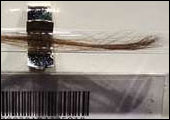


Italian version
Ê .art

20.02.03 Art in Output, the appeal of lost data.
Art in Output, an international biennial on the intersection of art, technology and society, opened a few days ago at the Technische Universiteit of Eindhoven (The Netherlands). It's one of the few exhibitions aimed at university students, this time more than 6.000, who are actively involved both in the making and the enjoyment of it, even to the point of having a special programme where they are picked up at their homes by a bus having on board the installation Hidden Track made by the group e-Xplo, from New York, where they are introduced to the main concepts to enjoy once arrived. This year's theme is 'Lost and Found', and it consists in seeing data files as if they were lost objects in an airport or a train station, therefore taken out of the context of the original owner, to be given a new function or meaning by a new user. There will be a seminar dedicated to data loss where, starting from the disappearance of languages and documents in the Middle Age, will be described the modern strategies of conservation of digital works. The main feature of the festival is the exhibition of interactive installations: 'You think therefore I am (following you)', by the french Magali Desbazeille and Siegfried Canto, where, by crossing the steps of reflected passers-by, it's possible to hear their thoughts; 'Remain in light', by Haruki Nishijima (Japan), with the famous butterfly net which can receive electromagnetic signals; 'The giver of names', by David Rokeby, where a computer tries to describe the objects around it using a shape recognition software and a word database; 'S.N.O.W.D.O.M.E. reanimated', by Jennifer Petterson, something like a souvenir glass ball where, instead of the falling snow there are slowly falling obsolete media (floppy, super8, VHS...); 'Homo indicium', by Ioannis Yessios, a collection of digital identities donated by the visitors; 'Summoned voices', by Iain Mott and Marc Raszewski, where phrases given by the visitors are assimilated and rewritten by the walls which, at last, have got their own memory; 'DAP Disguises', by Roel Wouters, a machine which can delete the informations about the user from unauthorised databases (marketing agencies, polls, providers, etc.). A particular attention has been paid to the site's interface, made in Flash and using innovative navigation techniques, with a top bar which traces the followed path and an algorithmic design which communicates very well the feeling of the rich contents.